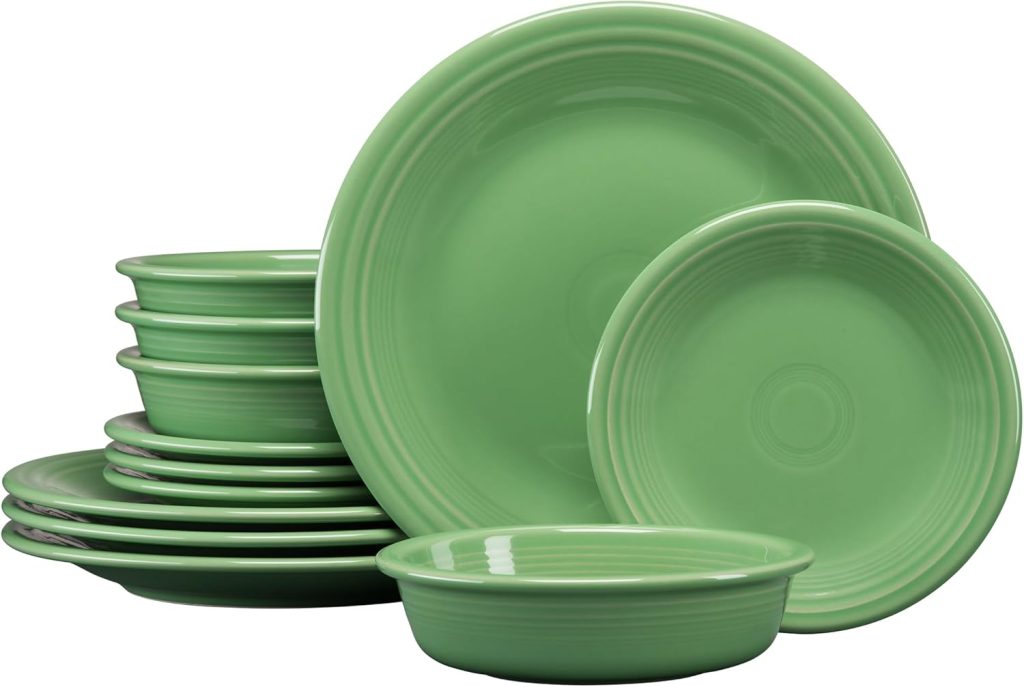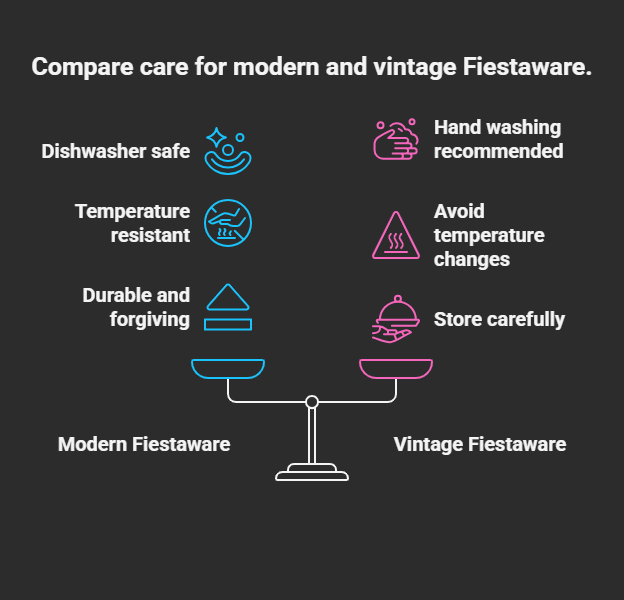When you think of vibrant, cheerful dinnerware that instantly brightens any dining room, Fiestaware likely comes to mind.
This iconic American ceramic dinnerware has been gracing tables since 1936, captivating generations with its bold colors and timeless Art Deco design.
But Fiestaware is more than just pretty dishes – it’s a piece of American manufacturing history, a collector’s treasure, and surprisingly practical tableware that’s built to last.
Whether you’re a seasoned collector hunting for rare vintage pieces, a safety-conscious homeowner wondering about lead content, or simply someone considering adding some color to your kitchen, this comprehensive guide covers everything you need to know about Fiestaware dinnerware.
What Makes Fiestaware Dinnerware Special?
Created by the Homer Laughlin China Company in 1936, Fiestaware revolutionized American tableware with its bold, saturated colors and innovative glazing techniques.
Designer Frederick Hurten Rhead drew inspiration from the Art Deco movement, creating pieces with clean lines and a distinctive concentric ring pattern that remains virtually unchanged today.
Unlike many dinnerware brands that focus on delicate patterns or traditional white pieces, Fiestaware made color the star.
From the original palette of red, blue, green, yellow, and ivory to today’s extensive seasonal collections, these dishes transform ordinary meals into celebrations.
The brand’s longevity stems from its unique combination of artistic design and practical durability. What is Fiestaware made out of?
The answer lies in its high-quality ceramic construction, which makes these pieces surprisingly resilient for everyday use while maintaining their vibrant appearance for decades.
Understanding Fiestaware Materials and Safety
One of the most important considerations for modern buyers is safety. With increased awareness about heavy metals in dinnerware, many people ask: Is Fiestaware lead and cadmium free? The answer varies significantly between vintage and modern pieces.
Modern Fiestaware, produced since 1986, meets current FDA safety standards and is considered lead-free for food contact surfaces.

However, vintage pieces from the original production run (1936-1972) contained lead in their glazes, particularly the iconic red and yellow colors.
This doesn’t mean vintage pieces are dangerous when properly used, but it’s crucial information for collectors and users alike.
The ceramic composition itself contributes to Fiestaware’s durability and heat retention properties.
The dense, vitrified clay body can withstand significant temperature changes, making it suitable for various cooking applications.
Speaking of which, many users wonder can Fiestaware go in the oven? The answer is yes, with some important temperature and usage guidelines to follow.
Identifying and Dating Your Fiesta Dinnerware
For collectors and curious owners, understanding how to identify authentic Fiestware is essential. The marking system provides valuable clues about age, authenticity, and value.
Do all Fiestaware have markings? Not every piece bears visible stamps, which can complicate identification.
When you do find markings, they tell a fascinating story. What does HLC mean on Fiestaware?
These letters represent Homer Laughlin China Company and appear in various forms depending on the production era.
The comprehensive Fiestaware vintage markings guide helps decode these stamps, revealing manufacturing dates and authenticating pieces.
The marking evolution reflects the brand’s history:
- Original Period (1936-1972): Featured various HLC stamps, often circular with “Fiesta” or “Genuine Fiesta”
- Contemporary Period (1986-present): Shows “FIESTA” impressed in block letters with “HLC USA”
Understanding these markings becomes crucial when determining value, as vintage pieces often command premium prices, especially in rare colors or discontinued items.
Caring for Your Fiestaware Collection

Proper care ensures your Fiestaware maintains its beauty and functionality for generations. Modern pieces are generally dishwasher-safe, but vintage collectors often ask can vintage Fiestaware go in the dishwasher?
The answer requires understanding the differences between old and new manufacturing processes.
Modern Fiestaware Care:
- Dishwasher safe on all cycles
- Microwave safe (except pieces with metallic trim)
- Oven safe up to 350°F
- Freezer safe
- Resistant to chipping and crazing
Vintage Fiestaware Care:
- Hand washing is recommended to preserve value
- Gentle detergents only
- Avoid extreme temperature changes
- Store carefully to prevent chipping
The durability that makes Fiestaware practical also makes it forgiving. Minor scratches often buff out, and the solid-color glazes hide wear better than patterned dinnerware.
Fiestaware vs. Other Dinnerware Brands
When choosing dinnerware, comparing options helps inform decisions.
The Corelle vs Fiestaware comparison highlights key differences between these popular American brands.
While Corelle emphasizes lightweight durability and space-saving storage, Fiestaware offers bold colors and substantial heft that many prefer for special occasions.
Fiestaware Advantages:
- Vibrant, extensive color palette
- Substantial feel and heat retention
- Collectible value potential
- Made in the USA heritage
- Mix-and-match versatility
Considerations:
- Heavier than alternatives
- Higher price point
- Color availability varies by season
- Vintage pieces require careful handling
Collecting Fiestaware: A Beginner’s Guide
Fiestaware collecting has passionate enthusiasts worldwide. Whether starting a collection or adding to existing pieces, understanding the collecting landscape enhances the experience.
What Makes Fiestaware Collectible:
- Historical significance: Nearly 90 years of production history
- Color variety: Over 50 colors produced across different eras
- Limited editions: Special releases and discontinued colors
- Quality consistency: Reliable craftsmanship across decades
- Investment potential: Some rare pieces appreciate significantly
Collecting Considerations:
- Authenticity verification: Importance of genuine pieces
- Condition assessment: How wear affects value
- Rarity factors: What makes certain pieces valuable
- Display and storage: Proper care for collections
- Market trends: Understanding current collecting interests
Fiestaware Dinnerware Color Guide
Fiestaware’s rainbow of colors is perhaps its most distinctive feature. Colors have been introduced, retired, and reintroduced throughout the company’s history.
Original Colors (1936):
- Cobalt Blue
- Light Green
- Red
- Ivory
- Yellow
- Scarlet
- Turquoise
- Lapis
- Sunflower
- Shamrock
- Medium Green (most valuable)
- Chartreuse
- Forest Green
- Gray
- Rose
Each color has its own story, production period, and current availability, making color knowledge essential for both users and collectors.
Building Your Fiestaware Collection
Whether starting fresh or expanding an existing collection, understanding the range helps make informed purchases. Fiestaware offers complete place settings, serving pieces, and specialty items across multiple product lines.
Essential Pieces for Beginners:
- 4-piece place setting (dinner plate, salad plate, bowl, mug)
- Serving bowl and platter
- Salt and pepper shakers
- Creamer and sugar bowl
Popular Collector Items:
- Discontinued colors (especially vintage red, cobalt, and forest green)
- Specialty pieces (pitchers, teapots, candlesticks)
- Holiday and limited edition items
- Original promotional pieces
Current vs. Retired Colors: Fiestaware continuously evolves its color palette, retiring some shades while introducing new ones. This creates collecting opportunities as retired colors often appreciate in value.
Popular current colors include Scarlet, Turquoise, and Sunflower, while retired favorites like Persimmon and Plum command premium prices.
Where to Buy and What to Expect
Fiestaware is widely available through department stores, specialty retailers, and online platforms. Pricing varies significantly between new and vintage pieces, with factors including:
- Rarity: Discontinued colors and limited production pieces
- Condition: Chips, cracks, or crazing significantly impact value
- Age: Vintage pieces generally command higher prices
- Completeness: Full sets are worth more than individual pieces
Buying Tips:
- Inspect pieces carefully for damage
- Verify authenticity through proper markings
- Understand return policies, especially for vintage items
- Consider mixing colors and eras for unique table settings
- Join collector groups for market insights and authentication help
The Future of Fiestaware Dinnerware
Nearly 90 years after its introduction, Fiestaware continues evolving while maintaining its core appeal.
Homer Laughlin Company regularly introduces new colors, often retiring others to keep the line fresh and collectible.
Recent innovations include holiday collections, textured finishes, and collaborations that expand the brand’s reach.
The company’s commitment to American manufacturing distinguishes Fiestaware in an increasingly global market.
Production remains in Newell, West Virginia, supporting local communities while maintaining quality control that ensures each piece meets the brand’s exacting standards.
Environmental consciousness also influences modern Fiestaware production, with the company implementing sustainable practices while maintaining the durability that makes these pieces lifetime investments rather than disposable goods.
Fiestaware Tableware in Modern Kitchens
Today’s Fiestaware seamlessly blends vintage charm with modern functionality. Current production meets contemporary needs while maintaining the classic aesthetic that made Fiestaware famous.
Modern Kitchen Integration:
- Mix-and-match philosophy: Different colors create personalized sets
- Special occasion use: Elevates everyday dining
- Gift giving: Popular for weddings, housewarmings
- Restaurant use: Many establishments choose Fiestaware for its durability and style
Current Production Features:
- Microwave safe: Modern glazes and construction
- Freezer safe: Suitable for food storage
- Lead-free: Meets all current safety standards
- Chip-resistant: Improved durability over vintage pieces
Frequently Asked Questions About Fiestaware
Fiestaware offers excellent value through durability, timeless design, and potential collectible appreciation. Quality pieces can last generations with proper care.
Yes! Fiestaware was designed for mixing and matching. Different colors from the same era typically coordinate well together.
Check markings, weight, glaze characteristics, and color. Vintage pieces (pre-1973) often have different stamps and slightly different proportions than modern pieces.
Generally, yes for most colors, but test vintage pieces for lead if using with food regularly. Some red/orange vintage colors contain uranium and should be used sparingly.
Conclusion: Why Fiestaware Endures
Fiestaware’s lasting appeal stems from its unique combination of artistic merit, practical functionality, and emotional connection.
These aren’t just dishes – they’re conversation starters, mood elevators, and family heirlooms that connect us to American design heritage.
Whether you’re drawn to the collecting aspect, the safety considerations, the practical benefits, or simply the joy of eating from beautiful dishes, Fiestaware offers something special.
Its ability to transform everyday meals into celebrations while standing up to decades of use explains why generations continue discovering and rediscovering this iconic American dinnerware.
From understanding vintage markings to ensuring proper care, from comparing brands to building collections, Fiestaware represents more than tableware; it embodies the American spirit of bold design, quality craftsmanship, and enduring value.
In a world of disposable goods, Fiestaware reminds us that some things are worth keeping, collecting, and passing down through generations.
Ready to dive deeper into specific aspects of Fiestaware? Explore our detailed guides above for expert insights into identification, care, safety, and collecting strategies.